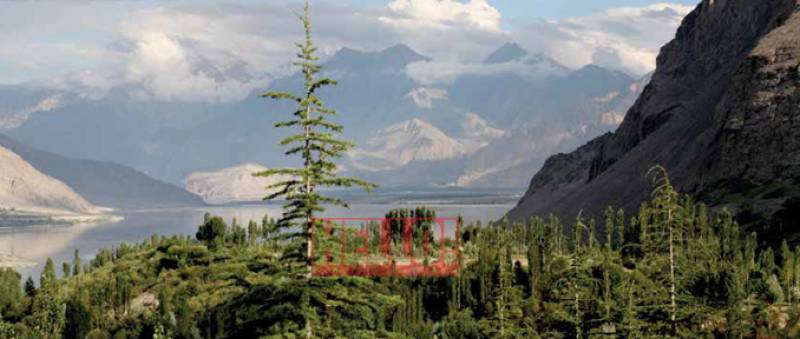Deosai Dreaming

It is not a place that receives many visitors. The tracks within the Deosai National Park are for the most part bone-shakingly bumpy, while the climb up to Deosai from Skardu is strewn with fallen rocks and shale and the narrow road plunges to sheer drops of hundreds of feet just beside you. Taking the flight to Skardu is the first leg of the journey. As Deosai is only accessible for a few short months every summer – that is when you can see Skardu and its abundant fruit trees, heavily laden with almonds and apricots, plums and cherries, and the pale green poplars delicately paint-brushing the sky. The pine forest trail at the Shangrila Resort is worth the climb for the breathtaking views of the Indus in full flow, shimmering and wide as an inland
sea, and the surrounding Karakoram Mountains.
A sturdy jeep is a must for the ride up to Deosai, plus a very reliable driver, to whom you would be willing to trust your life! The first spectacular sight you see coming out of Skardu is the Sadpara Lake – artificially created when the river was dammed, its hues of turquoise and lapis blue are dazzlingly, setoff by the surrounding dusty beige of the mountains.
There are two small hotels on the lake where you can stop for tea and enjoy a boat ride, if you’re up for it.
Further along the route, rivulets of crystal clear snow-melt bounce off the rocks and gush their way through the valleys. The view is spectacular – hard granite mountains, dotted with patches of green grass and bushes at every twist and turn of the road
and a few gnarled and splendid Juniper trees still remain along the way. The trip takes nearly three hours by road and I would advise you plan your journey with plenty of time for photo stops.
Entering Deosai from the top of surrounding hills means you get the first all-encompassing view of the massive plateau. Its river snakes along through the meadows, with vast sweeps of wildflowers on its banks, each patch a brilliant single colour of puce or yellow, blue or white. Green hills abound on every vista, mottled with purple, dotted with beige rocks and boulders, beyond which lie the distant mountains of the Karakorams and the western Himalayas. The magnificent Nanga Parbat can be
glimpsed from here on a clear day.
Hiking in these hills is relatively easy, if you are not encumbered with altitude issues. The sun is fierce at this elevation, so hats should be broadbrimmed and sunblock prodigiously applied. The impressive Sheosar Lake is within the park and is one of the highest lakes in the world. The surrounding narrow grassy plain is interspersed with marshland filled with lime green spongy lichen and yellow flowers. It is a stunning yet tranquil place to spend half a day picnicking and kayaking (you have to take your own.)
Golden marmots, acting as sentinels on their mounds or bounding away with their fat bottoms bouncing up and down, are everywhere, and a sighting of a red fox or a gray wolf is a distinct possibility. The park also boasts over 124 varieties of
resident and migratory birds including eagles, vultures and falcons and the brilliant yellow tiny wagtails. Bears, however, are rare and hard to find though they can be attracted to garbage in the camp and will come in under the cover of darkness, as we discovered, so care must be taken.
The park was established in 1993, along with the Himalayan Wildlife Project, to protect the survival of the Himalayan brown bear and its habitat. The bear has long been a prize kill for poachers, but now has a hope for survival in Deosai where its numbers have increased from only 19 in 1993, to around 50 today.
As no solid construction is allowed in Deosai National Park, camping is the only option if you plan to stay overnight, but be warned, the nights can get extremely cold, even in the summer. The profusion of stars in the night sky, starting early in the evening with Venus in the West and later the whole Milky Way becoming visible from end to end, makes the trip well worth the effort.
The raw natural beauty of Deosai is an adventure not to be missed – it is a perspective into a world rarely glimpsed and barely recognisable as part of the Pakistan most of us know today.
